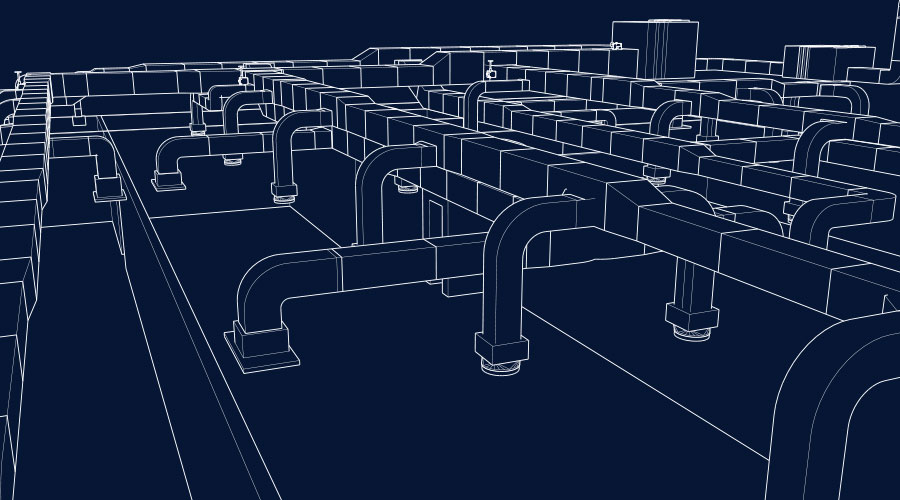The Unexpected Benefits of BIM
Facilities managers probably know about the tangible benefits of the digital technology, but its potential goes far beyond the surface
By Dan Hounsell, Senior Editor
OTHER PARTS OF THIS ARTICLEPt. 1: This PagePt. 2: 3 Roadblocks to BIM
For decades, facility owners and managers have watched with keen interest as advances in technology moved them closer to achieving a longstanding goal — being able to use digital technology to monitor, operate and maintain buildings more effectively. They have hoped that accessible and reliable digital images and data will enable them to oversee facilities that are more energy efficient, cost-effective and safer.
Among the most promising technologies that aimed to help building owners and managers achieve these goals is building information modeling (BIM), which is digital representations of the physical and functional characteristics of buildings that emerged in the early 1980s in the construction industry.
“Construction was one of the earliest adopters related to BIM and then architecture, but the use of BIM was integral to their phases of shaping the built environment,” says Allen Angle, VDC-FM integration manager with JLL Technologies. “As BIM has become the de facto delivery method, facility managers are increasingly recognizing its value for earlier and more robust asset management, exploring the inner workings of building and other facility operations and maintenance processes.”
But the process of implementing BIM to support facilities management in institutional and commercial buildings has been slow, in part because organizations have yet to fully understand the range of benefits BIM can deliver. While some of these benefits are apparent, others often are below the surface.
Tangible benefits
BIM has been around and expanding its presence for long enough that while facilities managers might not have made the leap yet to implementation, they understand the technology’s potential benefits for facilities.
Adam Roth, BIM/VDC director at Henderson Engineers, identifies the most common and tangible benefits of BIM in facility management as: improved collaboration and communication among stakeholders; more accurate and up-to-date information for maintenance and operations; increased efficiency and space automation and utilization; and enhanced facility performance through data-driven decision making.
One common benefit of BIM relates to an often-elusive goal for managers who oversee maintenance and engineering tasks — efficient maintenance planning.
“One of the more important (benefits) has been data standards related to defining the assets the owner is interested in tracking during design and construction and what data to collect and exchange for those assets,” Angle says. “The result is more efficient maintenance planning, scheduling and tracking of assets, leading to reduced downtime and costs.”
Angle says BIM also can help managers oversee facilities more effectively from the time of handover after the construction phase — provided managers are prepared.
“Creating clear expectations at the beginning on items the owner is interested in related to the model development and deliverables is another benefit,” Angle says. “As BIM facilitates better communication and collaboration among stakeholders, the use of those BIMs downstream is also critical to the lifecycle of this digital representation of the building. As I always tell our clients, ‘Just because you had a model delivered that does not mean it’s ready to be connected to your IWMS or CMMS tool.’”
Benefits below the surface
The unexpected benefits of BIM technology go beyond those that are apparent at first glance, in part by giving managers access to critical data generated during a facility’s construction phase has ended.
One such benefit involves situations that are among the most critical in facilities — better emergency planning and response.
“BIM models can provide more detailed information about building layouts and systems,” Roth says. “BIM allows the underlying data and floor plans to be connected. You can have more effective training and documentation that’s connected to your design intent and construction deliverables instead of just having bespoke documentation and training as a one-off.”
This benefit also extends to slightly less critical situations in which time is still of the essence, such as when looking for the source of a leak above a ceiling or inside a wall.
“When a critical room has water pouring in above the ceiling, tracing to find or remedy the problem has more than once been supported using the model to find valves or shut-offs to quickly address the emergency,” Roth says. “BIM can also help identify and mitigate potential risks before they escalate in future locations when a problem arises in another location.”
For managers looking for support in helping their organizations achieve sustainability goals, BIM offers help in the form of critical data on facility performance and conditions.
“BIM can facilitate sustainability initiatives by better enabling energy analysis and optimization throughout a building’s life cycle and providing that data for the underlying decisions,” Roth says. “These types of activities typically fall outside of the realm of traditional construction project deliverables that we’re involved with, and it’s placing the responsibility on the facility manager or the owner to handle those efforts.”
Similarly, BIM can provide managers with data that can help make smarter decisions during the planning renovations, upgrades and additions.
“Maintaining a model for the building lifecycle can jump-start the next potential change or remodel that needs to be studied and reviewed,” Angle says. “This can be a big win as sustainability, environmental and energy efficiencies continue to grow in the corporate real estate market.”
Related Topics:













